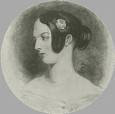
On the North wall of the library, one finds among the Dickens’ collection the manuscript of The Pickwick Papers, Dickens’ first novel, (written in serial form and published monthly) which catapulted him to fame at the age of 24. In March of 1837, the recently married Dickens, moved into 48 Doughty Street with his wife Catherine. Their frequent guest was her younger sister, Mary Hogarth, Catherine’s constant companion and chaperone during their courtship period and housekeeper during her first pregnancy. Dickens describes Mary as having “every attraction of youth and beauty” and credits her with “abilities far beyond her years”.
On May 6th, Mary accompanied the couple to the theater where the programme included one of Dickens’ farces Is She His Wife?. When they arrived home, Dickens wrote, “(Mary) went upstairs to bed at about one o’clock in perfect health and her usual delightful spirits.” Soon after, Dickens heard a cry from her room, rushed in, and discovered her in a critically ill state. Despite the best efforts of the doctor who was called in, Mary died at three o’clock the following afternoon, “In such a calm and gentle sleep,” Dickens wrote, “that although I had held her in my arms for some time before, when she was certainly living (for she swallowed a little brandy from my hand) I continued to support her lifeless form, long after her soul had fled to Heaven.”
Dickens was shattered at the death of “(the) dear girl whom I loved, after my wife, more deeply and fervently than anyone on earth”. He took the ring from her finger and wore it for the rest of his life. He wrote in a letter to a friend, “Thank God she died in my arms, and the very last words she whispered were of me…I solemnly believe that so perfect a creature never breathed, I knew her inmost heart, and her real worth and value. She had not a fault.”
Dickens composed the epitaph for Mary’s headstone:
Young, beautiful, and good,
God in His Mercy
Numbered her with his Angels
At the early age of Seventeen
and even expressed a wish to be buried next to her when his time came. He kept the clothes she wore, and named his first daughter after her. Several of his characters in his early novels are inspired by Mary’s innocence and goodness.
AND, for the first and only time in Dickens’ career, he missed a deadline. It was the June issue of The Pickwick Papers (as well as Oliver Twist which he was writing concurrently) and he explained to his readers that he had lost “ a very dear young relative to whom he was most affectionately attached, and whose society has been for a long time, the chief solace of his labours”. He wrote her mother “that pleasant smile and those sweet words which (were) bestowed upon an evening’s work in our merry banterings around the fire were more precious to me than the applause of a whole world would be.”
In 1841, Mary’s brother, George, died, and was laid to rest beside her. Dickens later wrote, “The desire to be buried next her is as strong upon me now, as it was five years ago; and I know (For I don’t think there ever was love like that I bear her) that it will never diminish…I cannot bear the thought of being excluded from her dust…it seems like losing her a second time.”
